I had known for a long time that I would eventually have to make an “in memory” donation.
- Back in September when it was a stroke
- Last January when it was innumerable brain metastases
- A year and a half ago when it was liver failure
It’s safe to say that my mom had been through a lot.

Me, my mom and my sister.
Amazingly though, she persevered, kept fighting, kept winning, kept her head high and spirit strong, that was, until two weeks ago. Unfortunately, my mom, Suzanne Shefska passed away after a two and half year struggle with lung cancer on June 30th, 2017.
For the entirety of her life, my mom was a fighter. She participated in clinical trials, was treated with chemotherapy, and tried nearly anything and everything in between to prolong her life. When she did pass two weeks ago it was at Massachusetts General Hospital in Boston. Not in Annapolis, Maryland where she lived. Not in Philadelphia, Pennsylvania where she was born. Not in either familiar location. Instead it was in Boston at MGH.
For well over a year, my mom travelled (on many occasions by herself) to Boston from Maryland (6am flights for a woman with terminal lung cancer, can you believe it?) for specific treatments and access to clinical trials. Her most recent trip was during the last week in June to begin a new clinical trial. I went with her.
We were together at MGH when her liver function tests came back a bit high. Per her oncologist’s recommendation she was admitted to the hospital right then and there.
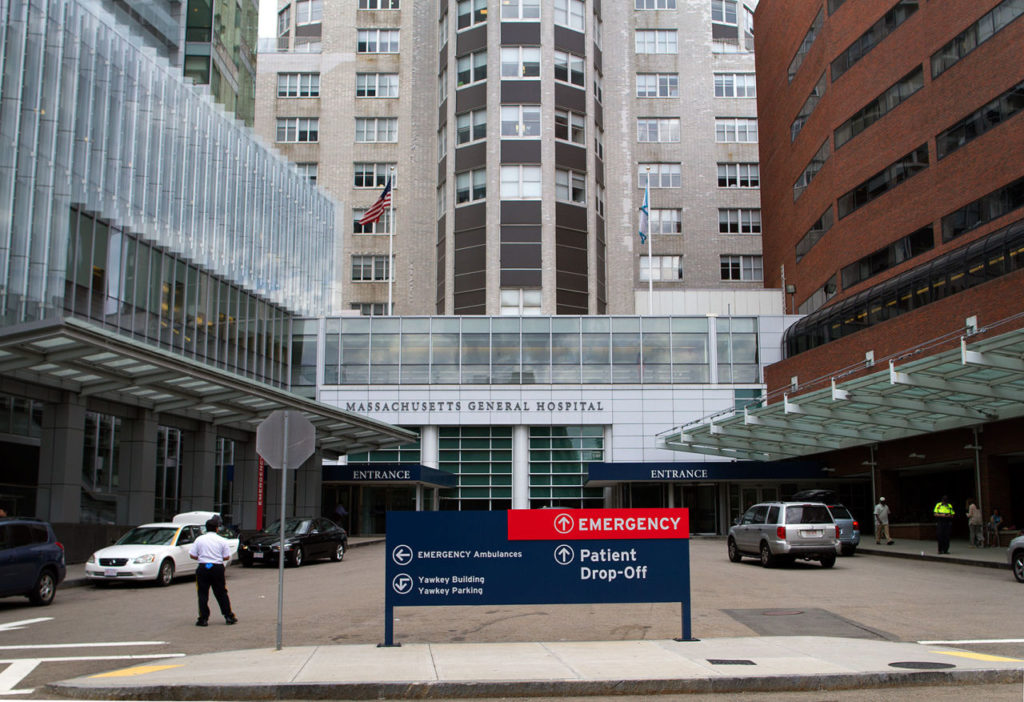
Whenever a cancer patient is admitted to the hospital and the doctors think it may be serious, there is a familiar drill. You call family and friends and they begin to trek to the hospital, wherever it may be. Fortunately for our family, every time this had happened we saw it through and all of us were able to walk out together, as a unit, a complete group.
Although geographically Boston is quite far from our home, it holds a special place in all of our hearts. Collectively we had come to know the doctors, nurses and case managers at MGH. We felt comfortable being there.
Sadly Suzanne’s liver never improved. This trip to MGH was her last.
Almost immediately after her passing, I made a donation in her memory to the hospital. For the remainder of this blog post, that’s what we will be focusing on — acknowledging in memory donations. We’ll use my most recent experience with MGH as a guide for what your organization should and shouldn’t do in terms of acknowledging memorial gifts, and we’ll also highlight a few of the challenges that development staff face everyday in cultivating meaningful relationships with memorium donors.
Let’s dive in.
What can we learn from MGH?
Mass General did a number of things well. Let’s start from the top. MGH has a super simple, easy-to-use donation landing page. Without making it easy for donors to give online, we wouldn’t be having a discussion about how to acknowledge in memory donors (they wouldn’t donate in the first place). MGH made it easy for me to give them money. During this difficult time in my life, I appreciated that.

After making my contribution, MGH impressed me with their automated confirmation/thank-you email. Just like their donation landing page, the follow up was simple, sweet and to the point.
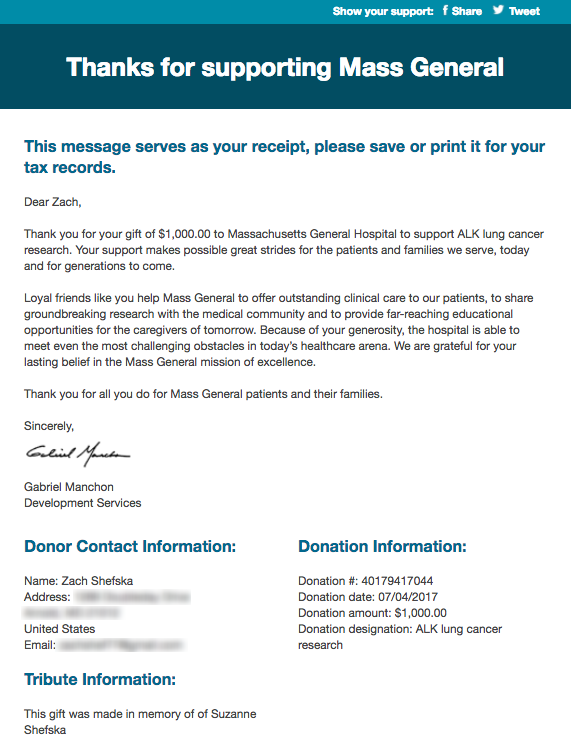
Up to now, this is the extent to which MGH has interacted with me since my donation (to be fair it has only been a week and there was a holiday during that time). And, sure $1,000 is not a “major” gift by any stretch of the imagination, but considering the circumstance (memoriam gift) and my age (I’m 21. Imagine what my lifetime value could be for them!!) I was, and still am, a bit surprised no one has contacted me. I’m sure someone will soon enough though.
Let’s transition to what MGH could (and hopefully will) do in addition to their automated email reply.
How to acknowledge a memorial donation
Let’s break down a great acknowledgement into three pieces.
- Immediate acknowledgement – “Hey, we got your money.”
- Personal acknowledgement – “Hey, we got your money. Thank you!”
- Genuine interest – “Hey, we got your money. Thank you! Um, why did you donate?”
MGH, as mentioned above, did an impressive job conducting step 1. Their system immediately acknowledged my gift, and I really appreciated that. It even reminded me that I made the donation in memory of my mom and that I wanted the funds to be directed towards ALK cancer research (her specific cancer mutation). Great!
Where they faltered (there is obviously still time to follow up on this) is with regards to the personal acknowledgement and genuine interest questions.
I’ve talked a lot on this blog about the importance of newly acquired donors. Many times I’ve said that I am not a fundraising expert (I’m still not), but even I know that newly acquired donors require some sort of special treatment — an acknowledgement, a phone call, something.
Well, memorial donors are even more special. Maybe I’m biased because of my recent circumstance, but they deserve, or better yet, require more pressing follow up and acknowledgement. Put yourself in their shoes for a moment. That donor either lost someone they cared deeply about, or they care about a person who is experiencing that loss and are offering their support (for the person experiencing loss more than your organization) through a donation. For one reason or another the person being memorialized had a meaningful enough connection to your organization to inspire others to make a donation on their behalf. Think about that. That’s deep. That’s intimate. That’s worthy of a personal, one-to-one conversation to learn more.
Ann Green has written extensively about how to acknowledge in memory donors. Check out her blog post from 2015, How Do You Acknowledge Your Memorial Gifts? to get another perspective on how to handle these special donors.
An automated acknowledgement is a great start. It allows a donor to confirm that their donation “went through,” but a personal acknowledgement, a real human being contacting you with regard to your contribution, carries much more weight . That one-to-one outreach creates a genuine connection and begins to develop a relationship. With memorial gifts, there is a certain timeframe you should strive to engage with donors within. (We preach about increasing donor retention rates on this blog This is one way to make sure that happens!!)
Strive to contact all in memorial donors within two weeks, 10 business days.
Within this timeline you will still have the energy and attention of a donor. Within ten business days you’ll be able to get a donor to pick up the phone. After that, one month later, two months later, a donor will be more frustrated than relieved to hear your voice.
After personally acknowledging a gift, you need to learn why that donor made their contribution. In my case a gift officer would learn that I really only have an interest in lung cancer research, and in particular, my mom’s specific ALK mutation. I know I will receive appeals relating to diabetes, obesity, etc., but none of those are as likely to resonate with me. If they do, I’ll give a little, but nowhere near my capacity because it’s not related to why I give.
During a personal follow up ask your donor why they care. “Why did you make this donation? Of course it was in memory of your mother, but what aspects of our mission most align with your personal goals?”
If a donor can’t answer that question then move on (odds are they’ll have an answer). It’s easy to forget because we’re all a part of this industry everyday, but donating is an intimate experience — memorial donations even more so. As development staff, make it your goal to learn more about the “why” so that you can focus your engagement with donors in the future on what they care about most .
Easier said than done
Everything I presented above is a sort of “best case scenario.” The reality is that having the information (oh, this guy is the son of a woman who was treated and passed away from cancer in our hospital) and the time (argggg, too many responsibilities, not enough time!!) is unrealistic.
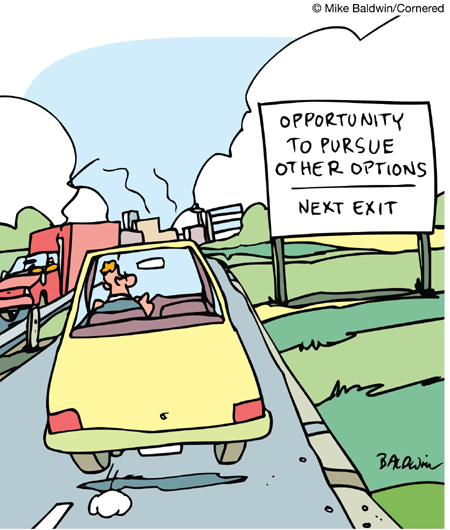
I acknowledged early in my career that development staff are overworked and underpaid, not to mention given tools that aren’t particularly useful.
Yet, with that being said, the “best case scenario” I outlined above can be accomplished by setting up some internal processes (again easier said than done, but worth exploring further).
Let’s start with the information piece, how is the staff at MGH supposed to know that my mom just died from lung cancer at their hospital? There are obvious, and good reasons why the fundraising department doesn’t have access to medical information (thank you, HIPPA) but what the office does have access to is my donation type. I made an in memory contribution. That’s our first flag that draws our attention.
Next, we can look at the name, who was the donation made in memory of? Oh, Suzanne Shefska, okay. Who made the donation? Oh, Zach Shefska. Here comes the kicker, Google search “Suzanne Shefska,” and then follow that up with a search for “Zach Shefska.”
This isn’t “prospect research,” but it kind of is prospect research. You can figure out in a matter of seconds that I recently lost my mom. Sure, not all in memory donors will be as easy to research and track, but again, it comes back to process. This needs to be a step in the process.
Second is the time component. Again, in memory donors are in a special situation and deserve prioritization. Should all in memory donors go to the prospect research department (if you have one) or be researched by a gift officer? Yes.
Again, think about the intimacy of the transaction. If you can prioritize learning a bit and connecting with in memory donors within 10 days you’ll be setting the organization up for success. No matter the size of your organization there needs to be some precedent set that all in memory donors are acknowledged quickly.
A compelling way to think about this is to understand that hidden gems exist in your database. To use myself as an example, I’m a hidden gem for this hospital. Because of my mom’s connection to their work and my age (earnings potential) I could easily see myself making meaningful gifts to this organization for the rest of my life.
It is undeniably difficult for someone on the development staff to know or acknowledge that just from looking at me as a record in their database, but the one way to get that information is the pick up the phone and call.
In memory donations are unbelievably meaningful. They’re intimate, they’re passionate and they deserve some special handling internally. Acknowledge. Make a personal connection. Learn why that donor donated. Those are the steps to cultivate significant relationships with these special type of donor.
To donate in Suzanne’s memory
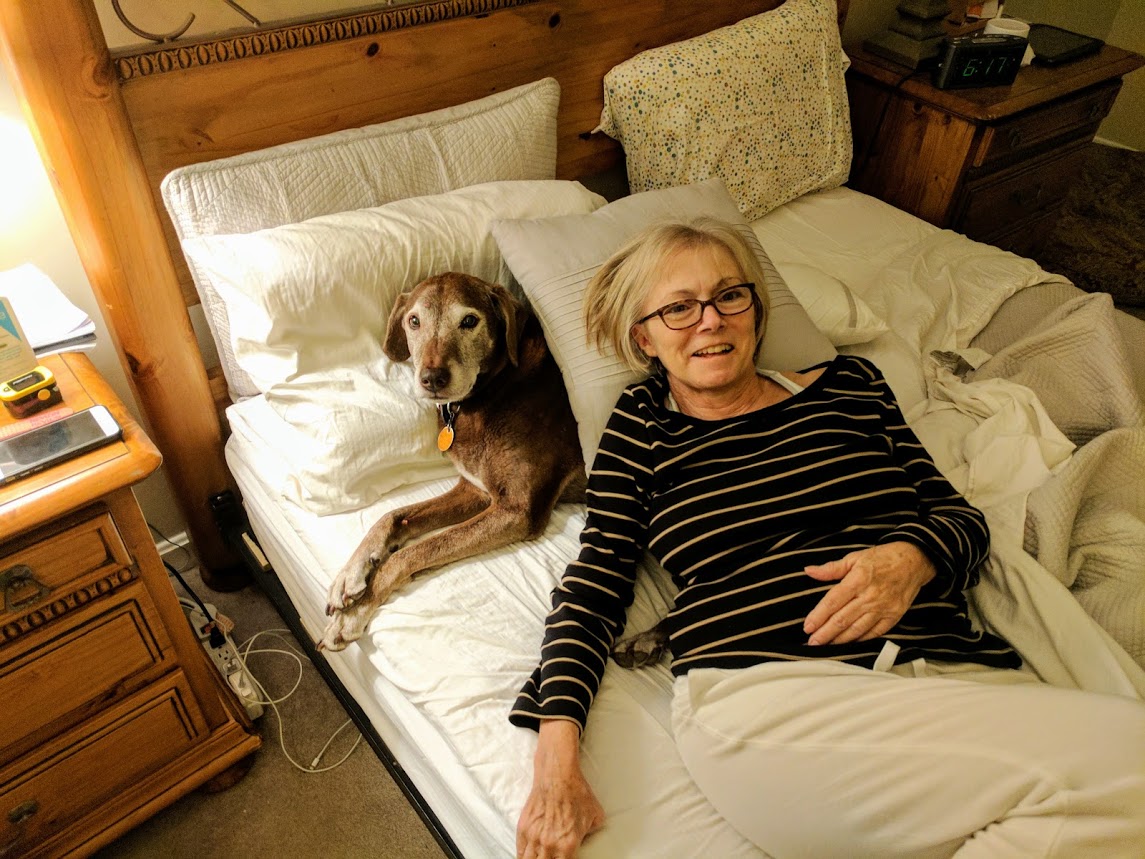
Suzanne and Cinnamon Shefska.
- Go to: giving.massgeneral.org/donate
- Scroll down to part 3, “Additional details”
- Check the “I’d like to designate this gift to a specific program or area,” box and enter, “ALK cancer research”
- Check the “I am making this gift in honor or memory of somebody,” box and enter, “in memory of Suzanne Shefska”

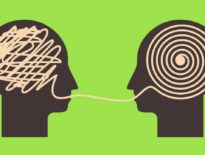
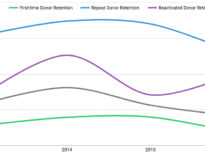

Great article! I recently made an online memorial donation to the wrong church. I meant to donate to a church in Kentucky, but somehow donated to a church with the same name in Virginia. The Virginia church actually realized my mistake and called me to tell me they would send a check to the correct church. They copied me on the letter explaining what had happened. I was so impressed, I wanted to send a donation to that Methodist church in Virginia! (FYI: I have yet to receive a thank you from the correct church.)
Thank you for the good article Zach. A good reminder even for an organization like Kansas City Hospice where most of our donations are memorials. I am sorry to hear about your Mother’s death but impressed that her memory will live on with the gifts you make in her memory that will help the lives of others.
Dear Zach – I’d just like to offer my deep sympathies on the loss of your mother. I always enjoy reading your posts and I admire you for sharing your thoughts at what must be such a difficult time for you.
Helen
Wonderful article Zach. I would be interested in how one might respond to the “Why did you give” question if the answer is: “That’s where donations were directed in the obituary.” I know a lot of people – myself included – will give to a charity of the deceased or family’s choosing, but I am not at all interested in that charity and will never give again. As a fundraiser, do you or should you try to engage these types of donors? And related to that, if you do find out that an in memory donor is interested, how soon should you engage them? They’ve just lost a loved one – do you wait six months? A year? Add them into your regular communications immediately? I’ve heard varying thoughts on that.
My deepest sympathies to you and your family on the loss of your mother.
Glynis